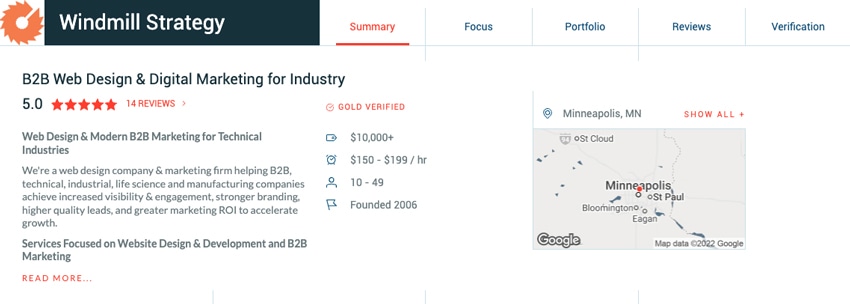Top 6 Marketing Tips for Industrial Automation Companies

Industrial automation companies, like so many in the B2B space, are often stretched thin when it comes to marketing.
Unfortunately, this means that many are falling short on the marketing basics. To make the most of limited marketing resources, it helps to be strategic and think long term. We have found that certain recommendations are applicable to most of our B2B technical and industrial clients.
The six marketing tips in this article include:
- Define Your Target Audience
- Regularly Write Engaging Content for Your Website
- Frequently Touch Base With Your Contact List (But Don’t Be Annoying)
- Offer Detailed Product and Service Pages With Quality Images
- Keep Your Contact Records Organized With a CRM
- Keep Third-Party Registries Up to Date
- Recap: Top 6 Marketing Tips for Industrial Automation Companies
Define Your Target Audience
The first crucial marketing tip is to clearly define your target audience. Many industrial automation companies fall short on knowing who their target audience is. Defining your target audience takes more than putting a list of your past clients up on a dartboard and letting a guess fly. On the other hand, we don’t mean you have to spend months doing exhaustive research, comparing charts, or creating millions of data points. Instead, we teach our industrial automation clients these basic steps in defining a target audience:
- Identify your highest-value customer groups and define your ICP (ideal customer profile)
- Understand key persona patterns for B2B technical companies
- Interview a few key customers to get more detail on what they’re looking for
- Create high-level personas
Here is a way to understand the key differences between your ICP and Personas:
ICP: What types of companies and customer groups do you want more of?
Personas: Who are the individuals most likely to make purchase decisions?
Ways to define your ICP include characteristics like industry, geography, company size, typical project budget, and others that might be more subjective. You will want to focus on profitable customers that generate high lifetime value, and those that will help you grow strategically. Your sales team will be an excellent source of insights as you develop your ICP.
As you go through this process, you will begin to see persona patterns, as well. It’s easy to go overboard on this. Instead of developing 12 highly-detailed fictitious personas, focus only on your top buyers. Commonly, there might be three: Who is the primary driver or influencer of the purchasing decision, who must approve it, and who might be researching it?
Important to note: the high-level personas you create should NOT be a 1-to-1 match with any of your current customers. The personas should be fictitious representations of the two or three types of leads that your company encounters during the sales process.
To see an example of both an ICP and a persona, and to gain more insight into the process of developing them, read our article called For B2B Marketing, Keep it Simple: Focus on Your ICP First, Personas Second. Sometimes, interviewing a few customers can be helpful in developing personas, and this article includes an extensive list of questions to ask during those interviews.
Regularly Write Engaging Content for Your Website
For all companies, not just industrial automation companies, one of the most important things you can do to increase traffic and optimize conversion rates is to create fresh, engaging content on a regular basis. The two clearest paths to doing this are updating your general website content and writing regular blog posts.
Updating Website Content
If you’re like other industrial automation companies, you probably had a writer or subject matter expert on your team write new content for your website when it first launched. Over time, you’ve added the occasional new product page or updated the About Us page. This is totally fine—we recommend not getting held up in the content phase when launching a website, as content can always be optimized later.
If your website is more than a few months old, it’s time to revisit the content to make sure it’s pulling in the target audience you defined. Our article on Planning Critical Website Content provides a good checklist for making sure no important sections are completely missing from your website:
- Overview of what you do (homepage)
- An overview and detailed information page for each product or service
- Case studies
- Market, industry, vertical, or application pages
- Information about the company and its history (About Us)
- An easy way to make contact (CTAs and contact page for SQLs)
- A reason to exchange contact information before a need to buy is imminent (gated content, gated tools or resources, etc., for MQLs)
- Resource library/articles/videos or other instructional materials
If you don’t quite know where to start, we recommend starting with your homepage. Our article on How to Organize your Homepage Website User Experience for Your Industrial Marketing Website can help you lay the foundation for additional content work. We have some very specific recommendations for wireframes, navigation, the “homepage hero” positioning statement, and other elements of an effective homepage.
Writing Regular Blog Posts (Articles) and Case Studies
As an industrial automation company, you have many opportunities to help teach and showcase your knowledge and past work through blog posts and case studies.
By posting articles regularly to your website (you might start with 2-4 per quarter, with an ultimate goal of 2-4 per month), you are widening your net, making it more likely that potential leads will find your business, and you are adding to your company’s reputation in terms of subject matter expertise. This of course instills trust and helps MQLs feel confident in making the decision to work with you. The caveat is that the content must be meaningful and well-written. Engineers have little patience for fluffy surface-level content written for SEO purposes only, so make sure that the engineer that lands on your article finds the experience worthwhile, and sees your company in a higher light after reading.
As your company completes industrial automation projects for customers, it’s important to document those projects and show them off to potential future customers, as a way to demonstrate the way that your team thinks, solves problems, and understands the different applications and industries of your clients. During the project, you should ideally be taking photos and noting any key wins or takeaways, at least of the aspects that can be publicly shared, so that a case study can be written after the project is complete. Not only will MQLs land on case study pages when doing research in Google, but case studies will also demonstrate your credibility. (It’s, of course, important to check with your customer that it’s okay to post the case study to your website.) In order to avoid giving away proprietary information, you can avoid using actual customer names and project specifics, but focus more on the way that your team went about solving the problems at hand.
As you dig into updating, expanding, and enhancing your website content, remember that a slow and steady approach is often the most effective in the long run. Build accountability into your content planning, and set a calendar for specific pieces of content, whether new case studies and blog posts, or new pages for specific products, services, or industries.
Frequently Touch Base With Your Contact List (But Don’t Be Annoying)
Have you ever unsubscribed from a company’s emails because they were just blatant advertisements, or because they sent so many that you just couldn’t handle it? Those are good examples of how NOT to email your contact list. The whole reason anyone would sign up for an industry-specific newsletter, like an industrial automation newsletter, is to learn something new and to stay informed in a concise, efficient way, without being overwhelmed.
On the flip side, many companies don’t send out newsletters or blog emails because they feel that it takes too much time or they can’t think of any content to send regularly. The biggest benefit of sending a regular email to your contact list is to keep your company top of mind with potential customers. Without regular emails, your potential customers, even those who’ve visited your website in the past, may not remember you when a need arises.
Remember those blog posts and case studies we recommended creating? These are perfect pieces of content to send out to your contact list because they will be relevant and engaging to your target audience. At Windmill, we suggest emailing your contacts twice per month—enough to keep you in the mix, but not so frequently that you will overwhelm or annoy them. But again, focus on quality over frequency, so if you’re generating content less often, let that guide your email cadence as you ramp things up.
Here is an example of a recent marketing email that we sent to our own contacts, previewing an article about website content and industrial sales enablement and offering a webinar on analyzing content performance.

Offer Detailed Product and Service Pages With Quality Images
Whether you sell specific products or offer a uniquely customized service, it’s important to make sure your product and service pages are content-rich and easy to read and understand. In addition to the words on the page, high-quality imagery distinguishes a website that looks credible and professional from one that looks less credible and less professional.
Keep in mind that a raw image file is most often too large and can slow down your website’s performance. In terms of search, Google takes into account image size and image naming, in addition to content length and SEO, when deciding where to rank your pages.
For everything you need to know about using images on your website, check out our article on digital asset organization. Among other concrete advice, the article provides guidance on when and how to use .jpg, .png, .gif, and .svg file formats. While original imagery is preferred, if you are using stock photos, they should also be of high quality, in the correct format, and with your own file name instead of the file name of the download.
Keep Your Contact Records Organized With a CRM
All too often, the salespeople at industrial automation companies and other B2B companies are working their own deals and managing their own contact lists, running things from email and spreadsheets. A CRM (customer relationship management) system allows you to keep all contacts in one dynamic location. The biggest benefits of this include:
- Keeping all contacts in one place
- Keeping a full communication history for each contact
- Sending regular emails or timely communications without the need to export your list(s) to another tool
- Tracking KPIs in one clean dashboard
- More accurate pipeline forecasting
When it comes to choosing a CRM, we recommend HubSpot to all of our clients, including industrial automation companies. Other common CRM options include Salesforce, and Zoho, and many ERP systems also have a CRM capability built in (although these can be less easily integrated with marketing automation systems in most cases.)
If you’re skeptical that a CRM is a must-have sales enablement tool for your business, we suggest checking out our article on 10 CRM Quick Wins to learn more about the benefits of implementing this type of system, from the efficiency of having a central repository of contacts to the insights gained from deal sourcing and lead scoring.
Keep Third-Party Registries Up to Date
Our final tip for industrial automation companies is to keep third-party registries up to date. This practice is often overlooked.
In today’s world, the majority of buying decisions happen after a lead has done preliminary research online. Websites like Xometry and Thomas, among other industry-specific directories and review sites are designed to showcase companies that are the best in their field. However, this also means that these websites compete with your website for key phrases in search engines. Often, they outrank individual companies in search results.
Since your potential customers are probably landing on these registry websites, it’s important that you claim your profiles and make sure they are up to date. Here is an example of Windmill Strategy’s listing on Clutch.co to help you better understand the information these registries display.

Managing listings in multiple registries can be a big task to take on, but based on our experience, it is worth the effort. Since you might not beat them, it’s definitely better to join them. As you watch the analytics for which sites refer the most traffic and conversions to your website, you’ll get a better understanding of which sites to spend the most time updating and maintaining on an ongoing basis.
Recap: Top 6 Marketing Tips for Industrial Automation Companies
Our top six marketing tips for industrial automation companies are more than quick tips or tricks. They’re strategic recommendations that will better position your company’s sales and marketing for success. Here they are again:
- Define Your Target Audience
- Regularly Write Engaging Content for Your Website
- Frequently Touch Base With Your Contact List (but Don’t Be Annoying)
- Offer Detailed Product and Service Pages With High-Quality Images
- Keep Your Contact Records Organized With a CRM
- Keep Third-Party Registries Up to Date


